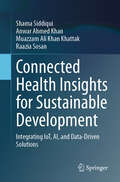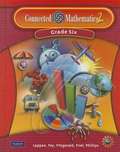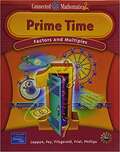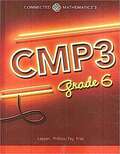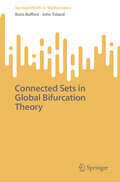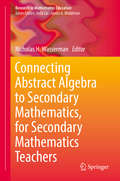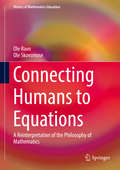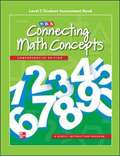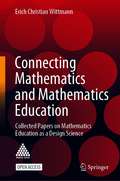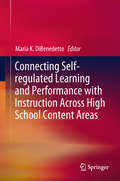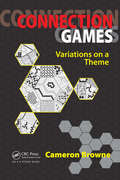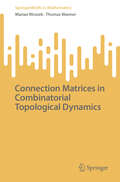- Table View
- List View
Connected Health Insights for Sustainable Development: Integrating IoT, AI, and Data-Driven Solutions
by Shama Siddiqui Anwar Ahmed Khan Muazzam Ali Khan Khattak Raazia SosanThis book offers a comprehensive look at how emerging technologies like IoT, Data Science, and AI can drive significant advancements in healthcare, particularly in alignment with Sustainable Development Goal 3 (SDG 3) – Good Health and Well-Being. By bridging technological innovation with the critical need for improved healthcare systems, this book explores how these technologies are revolutionizing both personal and population health management. Readers will gain insights into how IoT-enabled devices, AI-powered analytics, and data-driven decision-making tools enhance everything from continuous patient monitoring to personalized medicine and resource optimization for governments. The initial chapters provide a foundational understanding of IoT, AI, and Data Science, followed by in-depth discussions on their integration into healthcare applications. Key topics include continuous health monitoring through wearable technologies, the role of mobile health (m-Health) in making healthcare more accessible, and the use of advanced analytics in diagnosing diseases early. Personalized medicine is explored as a pivotal breakthrough in improving patient outcomes by leveraging data from IoT devices and AI-driven models to tailor treatment plans. Further, the book also covers the advancements in medical imaging and how it supports real-time diagnosis and treatment. Towards the latter part, the book delves into population health surveillance and healthcare resource management through the combined power of these technologies. It presents how governments and healthcare providers can optimize their resources, predict disease outbreaks, and manage pandemics more effectively. Additionally, ethical concerns surrounding the use of these technologies in healthcare are discussed, providing readers with a holistic view of both the opportunities and challenges posed by the IoT-Data Science-AI nexus in achieving SDG 3.
Connected Mathematics 2, Grade Eight
by Glenda Lappan James T. Fey William M. FitzgeraldNIMAC-sourced textbook
Connected Mathematics 2, Grade Seven
by Glenda Lappan James T. Fey William M. FitzgeraldNIMAC-sourced textbook
Connected Mathematics 2, Grade Six
by Glenda Lappan James T. Fey William M. FitzgeraldNIMAC-sourced textbook
Connected Mathematics 2: Prime Time
by Prentice Hall Dictionary EditorsConnected Mathematics 2: Prime Time / Factors and Multiples
Connected Mathematics 3
by Glenda Lappan James T. Fey Susan N. Friel Elizabeth Difanis Phillips Connected Mathematics (Project) StaffConnected Mathematics 3, Grade 6
Connected Mathematics 3, Stretching and Shrinking: Understanding Similarity
by Glenda Lappan James T. Fey Susan N. Friel Elizabeth Difanis PhillipsThe book helps students develop an understanding of important mathematical ideas by solving problems and reflecting on the mathematics involved.
Connected Mathematics 3: CMP3, Grade 7
by Glenda Lappan James T. Fey Susan N. Friel Elizabeth Difanis PhillipsNIMAC-sourced textbook
Connected Mathematics 3: Making Comparisons and Predictions
by Glenda Lappan James T. Fey Susan N. Friel Elizabeth Difanis PhillipsMath Textbook for 7th Grade
Connected Mathematics 3: The Families of Functions
by Glenda Lappan James T. Fey Susan N. Friel Elizabeth Difanis PhillipsMath textbook
Connected Mathematics: Accentuate the Negative, Integers
by Glenda Lappan James T. Fey William M. Fitzgerald Susan N. Friel Elizabeth Difanis PhillipsIn Accentuate the Negative one will develop understanding of and algorithms for operations with integers.
Connected Mathematics: Integers
by Glenda Lappan James T. Fey William M. Fitzgerald Susan N. Friel Elizabeth D. Phillips Cathy Anderson Stacey Miceli James P. Mcauliffe Roberta SpieckermanIn Accentuate the Negative, you will learn about integers and how to use them to represent real situations.
Connected Mathematics: Introducing Algebra
by Glenda Lappan James T. Fey William M. Fitzgerald Susan N. Friel Elizabeth Difanis PhillipsIn Variables and Patterns you will explore some of the basic ideas of algebra.
Connected Mathematics: Linear Relationships
by Glenda Lappan James T. Fey William M. Fitzgerald Susan N. Friel Elizabeth Difanis PhillipsMoving Straight Ahead explores properties of the most important type of relationship among variables, linearity.
Connected Mathematics: Number Sense
by Glenda Lappan James T. Fey William M. Fitzgerald Susan N. Friel Elizabeth Difanis PhillipsIn Data Around Us, you will explore ways to reason with quantities in order to build number sense.
Connected Mathematics: Ratio, Proportion, and Percent
by Glenda Lappan James T. Fey William M. Fitzgerald Susan N. Friel Elizabeth Difanis PhillipsWe use lots of different words to make comparisons--faster, stronger, taller, richer, smarter, heavier, safer, tastier, and so on. Sometimes, words alone give us all the information we need. It is enough to know that one box is heavier than another, one printer is faster than another, or one car is safer than another.
Connected Mathematics: Stretching and Shrinking (Similarity)
by Glenda Lappan James T. Fey William M. Fitzgerald Susan N. Friel Elizabeth Difanis PhillipsStretching and Shrinking explores the geometry concept of similarity.
Connected Sets in Global Bifurcation Theory (SpringerBriefs in Mathematics)
by John Toland Boris BuffoniThis book explores the topological properties of connected and path-connected solution sets for nonlinear equations in Banach spaces, focusing on the distinction between these concepts. Building on Rabinowitz's dichotomy and classical results on Peano continua, the authors introduce "congestion points"—where connected sets fail to be weakly locally connected—and examine the extent to which their presence is compatible with path-connectedness. Through rigorous analysis and examples, the book provides new insights into global bifurcations. Structured into seven chapters, the book begins with an introduction to global bifurcation theory and foundational concepts in set theory and metric spaces. Subsequent chapters delve into connectedness, local connectedness, and congestion points, culminating in the construction of intricate examples that highlight the complexities of solution sets. The authors' careful selection of material and fluent writing style make this work a valuable resource for PhD students and experts in functional analysis and bifurcation theory.
Connecting Abstract Algebra to Secondary Mathematics, for Secondary Mathematics Teachers (Research in Mathematics Education)
by Nicholas H. WassermanSecondary mathematics teachers are frequently required to take a large number of mathematics courses – including advanced mathematics courses such as abstract algebra – as part of their initial teacher preparation program and/or their continuing professional development. The content areas of advanced and secondary mathematics are closely connected. Yet, despite this connection many secondary teachers insist that such advanced mathematics is unrelated to their future professional work in the classroom. This edited volume elaborates on some of the connections between abstract algebra and secondary mathematics, including why and in what ways they may be important for secondary teachers. Notably, the volume disseminates research findings about how secondary teachers engage with, and make sense of, abstract algebra ideas, both in general and in relation to their own teaching, as well as offers itself as a place to share practical ideas and resources for secondary mathematics teacher preparation and professional development. Contributors to the book are scholars who have both experience in the mathematical preparation of secondary teachers, especially in relation to abstract algebra, as well as those who have engaged in related educational research. The volume addresses some of the persistent issues in secondary mathematics teacher education in connection to advanced mathematics courses, as well as situates and conceptualizes different ways in which abstract algebra might be influential for teachers of algebra. Connecting Abstract Algebra to Secondary Mathematics, for Secondary Mathematics Teachers is a productive resource for mathematics teacher educators who teach capstone courses or content-focused methods courses, as well as for abstract algebra instructors interested in making connections to secondary mathematics.
Connecting Humans to Equations: A Reinterpretation of the Philosophy of Mathematics (History of Mathematics Education)
by Ole Skovsmose Ole RavnConnecting Humans to Equations: A Reinterpretation of the Philosophy of Mathematics presents some of the most important positions in the philosophy of mathematics, while adding new dimensions to this philosophy. Mathematics is an integral part of human and social life, meaning that a philosophy of mathematics must include several dimensions. This book describes these dimensions by the following four questions that structure the content of the book: Where is mathematics? How certain is mathematics? How social is mathematics? How good is mathematics? These four questions refer to the ontological, epistemological, social, and ethical dimension of a philosophy of mathematics. While the ontological and epistemological dimensions have been explored in all classic studies in the philosophy of mathematics, the exploration of the book is unique in its social and ethical dimensions. It argues that the foundation of mathematics is deeply connected to human and social actions and that mathematics includes not just descriptive but also performative features. This human-centered and accessible interpretation of mathematics is relevant for students in mathematics, mathematics education, and any technical discipline and for anybody working with mathematics.
Connecting Math Concepts Level C Student Assessment Book
by Engelmann<P>The bus started out with 15 people. 32 more people got on the bus. How many people ended up on the bus?
Connecting Mathematics and Mathematics Education: Collected Papers on Mathematics Education as a Design Science
by Erich Christian WittmannThis open access book features a selection of articles written by Erich Ch. Wittmann between 1984 to 2019, which shows how the “design science conception” has been continuously developed over a number of decades. The articles not only describe this conception in general terms, but also demonstrate various substantial learning environments that serve as typical examples. In terms of teacher education, the book provides clear information on how to combine (well-understood) mathematics and methods courses to benefit of teachers. The role of mathematics in mathematics education is often explicitly and implicitly reduced to the delivery of subject matter that then has to be selected and made palpable for students using methods imported from psychology, sociology, educational research and related disciplines. While these fields have made significant contributions to mathematics education in recent decades, it cannot be ignored that mathematics itself, if well understood, provides essential knowledge for teaching mathematics beyond the pure delivery of subject matter. For this purpose, mathematics has to be conceived of as an organism that is deeply rooted in elementary operations of the human mind, which can be seamlessly developed to higher and higher levels so that the full richness of problems of various degrees of difficulty, and different means of representation, problem-solving strategies, and forms of proof can be used in ways that are appropriate for the respective level. This view of mathematics is essential for designing learning environments and curricula, for conducting empirical studies on truly mathematical processes and also for implementing the findings of mathematics education in teacher education, where it is crucial to take systemic constraints into account.
Connecting Self-regulated Learning and Performance with Instruction Across High School Content Areas
by Maria K. DiBenedettoThis book shows how principles of self-regulated learning are being implemented in secondary classrooms. The 14 chapters are theoretically driven and supported by empirical research and address all common high school content areas. The book comprises 29 lesson plans in English language arts, natural and physical sciences, social studies, mathematics, foreign language, art, music, health, and physical education. Additionally, the chapters address students with special needs, technology, and homework.Each chapter begins with one or more lesson plans written by master teachers, followed by narratives explaining how the lesson plans were implemented. The chapters conclude with an analysis written by expert researchers of the self-regulated learning elements in the lessons. Each lesson and each analysis incorporate relevant educational standards for that area. Different types of high schools in several states serve as venues.This powerful new book edited by Maria K. DiBenedetto provides a unique and invaluable resource for both secondary teachers and researchers committed to supporting adolescents in the development of academic self-regulation. Each chapter is jointly written by teachers who provide a wealth of materials, including lesson plans, and researchers who situate these lesson plans and academic self-regulation goals within the larger work on self-regulation. The topics covered are far broader than any other book I have seen in terms of developing academic self-regulation, covering over a dozen content areas, including literacy, mathematics, social studies, the sciences, and the arts. Teachers and scholars alike will find this book a must read.Karen Harris, EdD, Arizona State UniversityA practical and magnificent blend of educational research and application. This book goes beyond presenting the findings of research on self regulation by connecting detailed strategies that align with the standards to the research. DiBenedetto et al. clearly illustrate how to develop self regulated learners in the classroom. A refreshing must read for all secondary educators and educational researchers seeking to be well grounded in education research and practical application techniques. Heather Brookman, PhD, Fusion Academy- Park Avenue Self-regulated learning is a research-based process by which teachers help students realize their own role in the learning process. Connecting Self-Regulated Learning and Performance with Instruction Across High School Content Areas consists of model teachers’ lessons and analyses by prominent educational psychologists in the field of self-regulated learning. The book provides teachers with the tools needed to increase students’ awareness of learning and inspires all educators to use self-regulated learning to promote engagement, motivation, and achievement in their students. The book also provides administrators with the principles needed to infuse evidenced based self-regulated learning into their curriculum and instruction. I highly recommend the book!Marty Richburg, Northside High School
Connection Games: Variations on a Theme
by Cameron BrowneA comprehensive study of the connection game genre, Connection Games provides a survey of known connection games while exploring common themes and strategies. This book aims to impose some structure on this increasingly large family of games, and to define exactly what constitutes a connection game. Key games are examined in detail and complete rules for over 200 connection games and variants are provided. A connection game is a board game in which players vie to develop or complete a specific type of connection with their pieces. This might involve forming a path between two or more goals, completing a closed loop, or gathering all pieces together into a single connected group.
Connection Matrices in Combinatorial Topological Dynamics (SpringerBriefs in Mathematics)
by Marian Mrozek Thomas WannerThis book provides an introduction to the theory of connection matrices in the context of combinatorial multivector fields. The theory of connection matrices was proposed by Conley and Franzosa for classical continuous-time dynamical systems as a tool for studying connecting orbits between isolated invariant sets. It generalizes the Morse complex in Morse theory, and has found numerous applications in dynamics. Connection matrices have been and still are a challenging topic to study, as there are no complete introductory texts, and both their intricate definition and properties are scattered over numerous research papers. In recent years, dynamical concepts have found their way into a combinatorial context. Starting with combinatorial vector fields, introduced by Forman to generalize classical Morse theory, it has been realized that this transfer of ideas can lead to important applications. Similarly, Conley's theory of isolated invariant sets has been transferred to the combinatorial setting. This, when combined with the concept of multivector fields, opens the door to a complete combinatorial dynamical theory. In this book, we take Conley's theory one step further, by presenting a complete discussion of connection matrices for combinatorial multivector fields. While some of the results in this book are based on known approaches, we show in a detailed way how they can be carried over to the case of multivector fields on general Lefschetz complexes. Along the way, we introduce notions which are new even in the classical setting, such as a formal approach to addressing the nonuniqueness of connection matrices, as well as mechanisms for comparing connection matrices even under poset changes. Finally, we show that specifically for the case of Forman's gradient combinatorial vector fields connection matrices are necessarily unique, and can be determined explicitly in a straightforward way. Focusing on the combinatorial theory of connection matrices has a number of advantages. On the one hand, many of the technical difficulties of the classical continuous-time dynamics situation are not present in the discrete combinatorial context. This allows us to provide a complete and informal introduction to the theory in the second section of the book. This in turn will enable the readers to construct and analyze their own examples easily. On the other hand, the complete theory, including the existence of connecting orbits in the combinatorial setting can be presented in detail, based on an explicit distinction between the algebraic and topological parts of the theory. In this way, it is our hope that this book will be an impetus for further knowledge transfer between dynamics and combinatorics, and even topological data analysis. <span style="font-size: 12.0pt; font-family:
